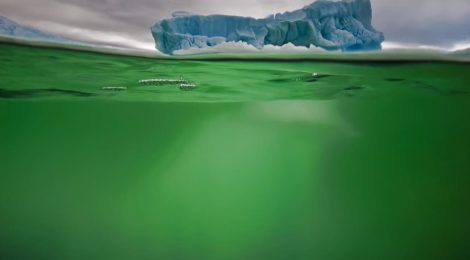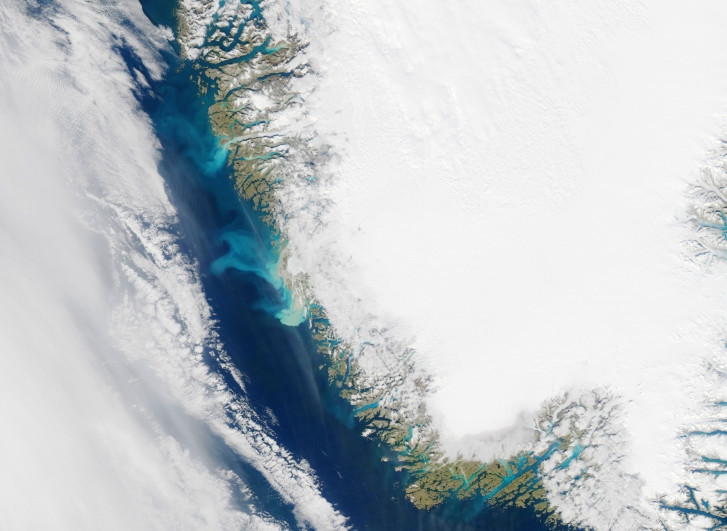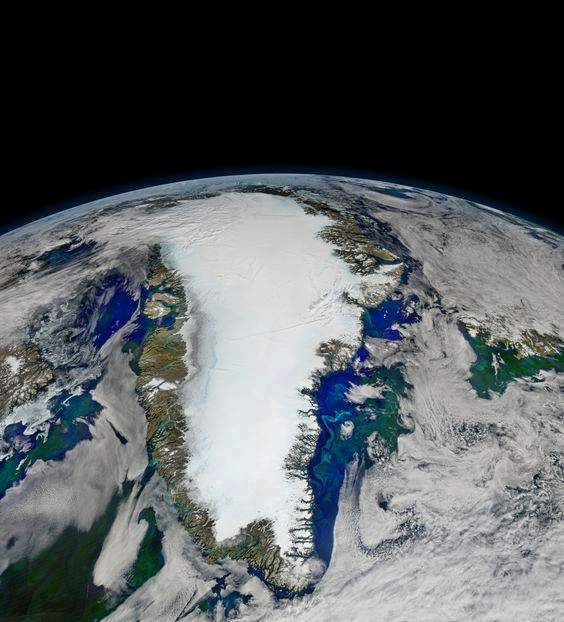
Ocean Pastures Bloom When Iron Arrives With Greenland Icy Meltwater
Frozen polar regions like Greenland accumulate mineral dust over the course of their endless succession of long winters.
When the ice eventually reaches the sea and melts the savings account of precious dust brings incredible dividends from Nature’s living trust.
Evidence is everywhere of the role of vital dust in sustaining ocean life.
Summer off the Greenland Coast.
Mineral dust containing iron accumulated over centuries and frozen in time in the glaciers of Greenland every summer reaches the sea and is spread by drifting currents. While the region is scarcely visited and thus most of the ocean pasture blooms are never recorded by humankind they are the primary source of nutrients for their waters. Just now a glimpse from a passing satellite has shown yet another Greenland bloom.
The image accompanies a new peer reviewed paper in the Journal Geophysical Research Letters, 17 June 2017.

Icy land produces green waters. Plankton blooms in the ocean pastures of the Greenland coast in the Labrador Sea. – Click to enlarge
Phytoplankton are the micro-plants that form the base of the food web throughout the world. “Phytoplankton serve as food for tiny zooplankton, like copepods and krill which in turn feed all of the fish and animals that depend on the 72% of this blue planet that is ocean. Because these vital ocean plants live in water they don’t depend on rain fall for their survival as plants on land do. They depend on the arrival of mineral dust that contains minute amounts of photosynthesis super-charging iron.
For most of the world’s ocean pastures the dust arrives in the form of dust fall, dust that blows to those pastures on the wind. But around the frozen polar regions the annual dust fall doesn’t make it to the ocean right away as it is locked away in the polar ice for times ranging from years to millenia. But when the ice melts get ready for the time of life.
Greenland’s summer phytoplankton bloom has mostly been unnoticed until satellites began watching this blue planet of ours. One small part of that blue expanse is the Labrador sea, some 200,000 sq. miles, that lies between Greenland and Canada’s Labrador coast.
“It’s one of those places where people just don’t sample very much,” say’s Stanford ocean scientist Ken Arrigo. “We have satellite images of this region going back years, but almost nobody’s looked at this particular spot during the summer.”
Arrigo and his team set out several years ago to discover what might be helping the ocean pasture off the coast of Greenland become green every summer. Marine biologists have naturally long known that the primary driver of every plankton bloom is sunlight. In polar regions where the world is locked away in ice for 9 months of every year there is little chance sunlight to sustain ocean pasture plankton blooms. Beneath the ice though the ocean’s water column is getting ready over the long winter night as cooling surface water sinks into the abyss and in return it displaces benthic nutrients such as nitrogen, phosphorus toward the surface.
“When spring arrives, then you’ve got sunlight and nutrients — the two ingredients you need for a bloom to occur,” Arrigo said.
However wonderful this process of preparation is, it doesn’t suffice to create the summer bloom. To solve the mystery of what might be driving the summer bloom, Arrigo and his colleagues compared NASA satellite imagery of the summer bloom and results from computer models simulating Greenland’s glacier melt and ocean currents. The stay at home team, in the comfort of the warm trendy California community of Stanford, found in their computers a significant correlation between the outflow of freshwater from Greenland’s melting glaciers and the timing of the bloom.
“The summer bloom develops about a week after the arrival of glacial meltwater in early July and persists until the input of glacial meltwater slows in August or September,” said coauthor and Stanford scientist Gert van Dijken.
In a new study published in Geophysical Research Letters, the scientists hypothesize that it’s not the influx of the meltwater itself that is triggering the summer bloom, but rather iron particles washed off from Greenland’s rocks and soil and ferried into the sea by the meltwater.
“The waters around Greenland happen to be one of the rare iron-limited places on Earth,” Arrigo said. “A lot of the photosynthetic machinery of phytoplankton requires iron. If they don’t have iron, they can’t capture light and make food.”
The summer meltwater is according to the academic researchers refreshing the iron supply in the seas around Greenland.
“All the pieces fit together,” Arrigo said. “The fact that when the runoff comes, the bloom starts. The runoff likely carries lots of iron with it.”
The stay at home scientists, inspired by their computer models, have submitted grant proposals to the National Science Foundation asking for millions needed to fund a summer research cruise to Greenland to test their hypothetical models.
“We want to go there before the summer bloom starts to measure the concentration of nutrients, especially iron,” Van Dijken said, “and then make the same measurements after the glacial meltwater arrives and the blooms start.”
Other coauthors on the study, entitled “Melting glaciers stimulate large summer phytoplankton blooms in southwest Greenland waters,” include Renato Castelao, Hao Luo, Hilde Oliver, Patricia Yager, and Thomas Mote of the University of Georgia; Åsa Rennermalm of Rutgers University; and Marco Tedesco of Lamont Doherty Earth Observatory and NASA’s Goddard Institute for Space Studies.









